
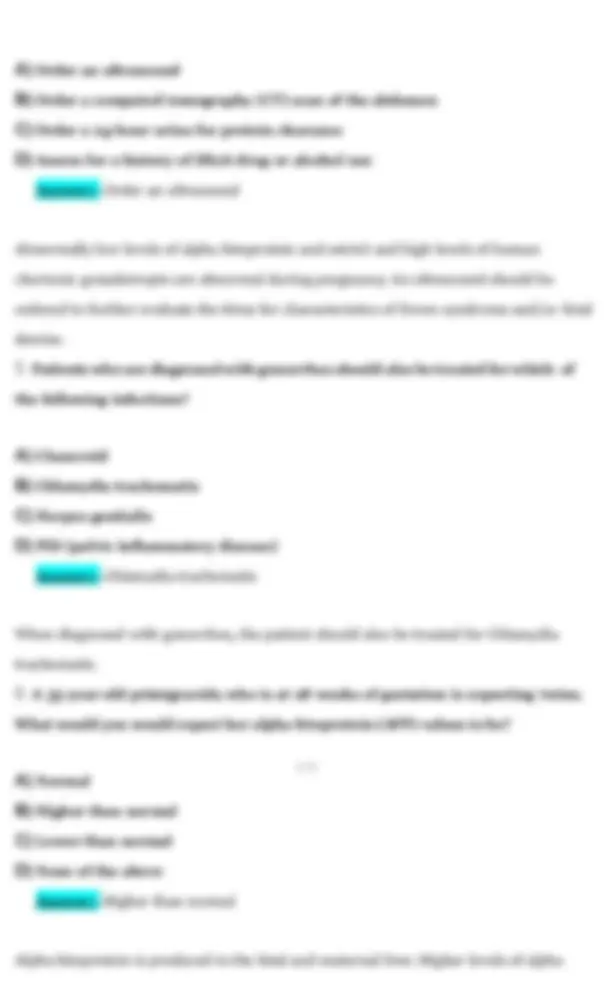

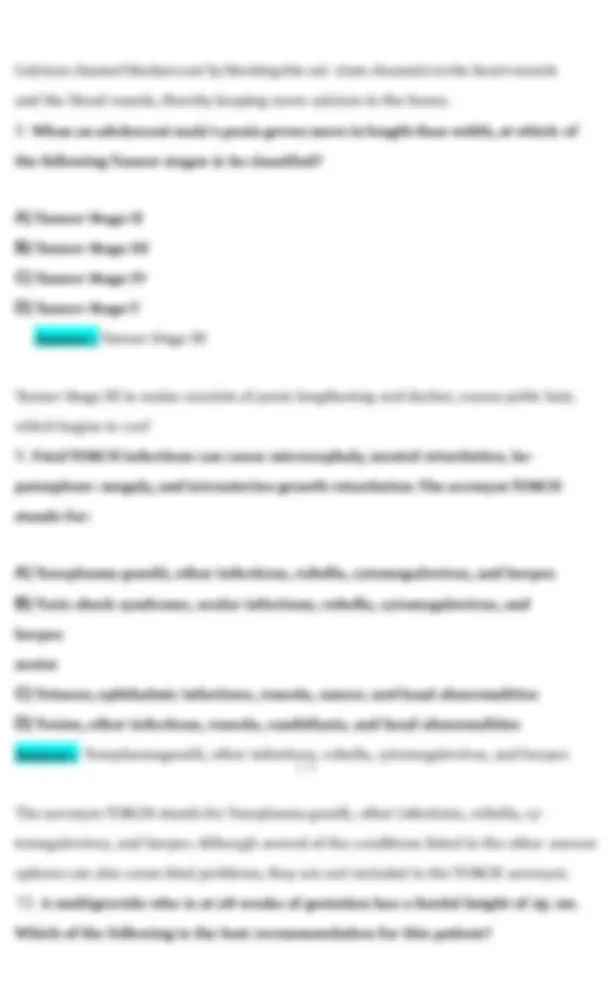

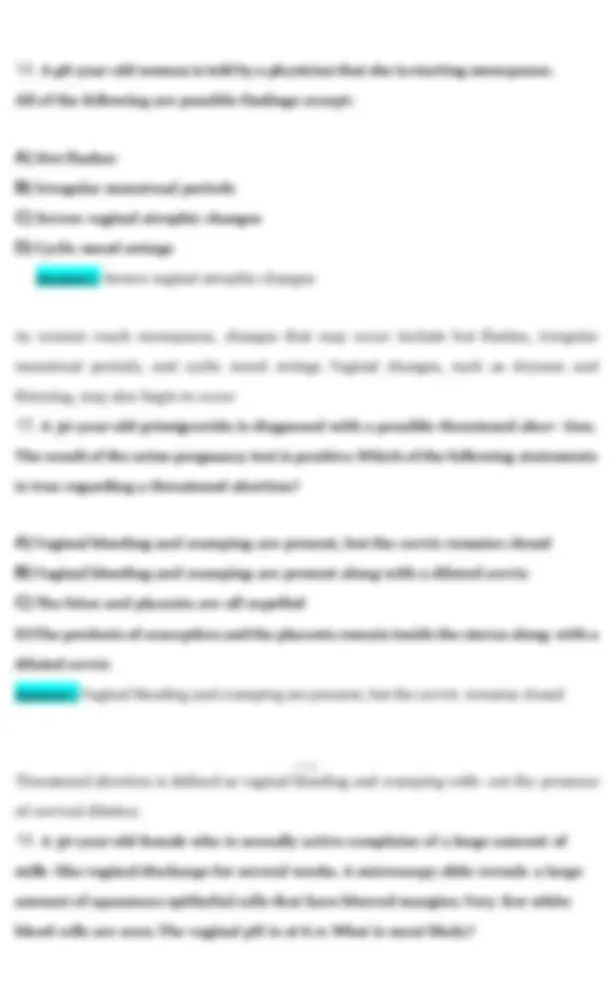

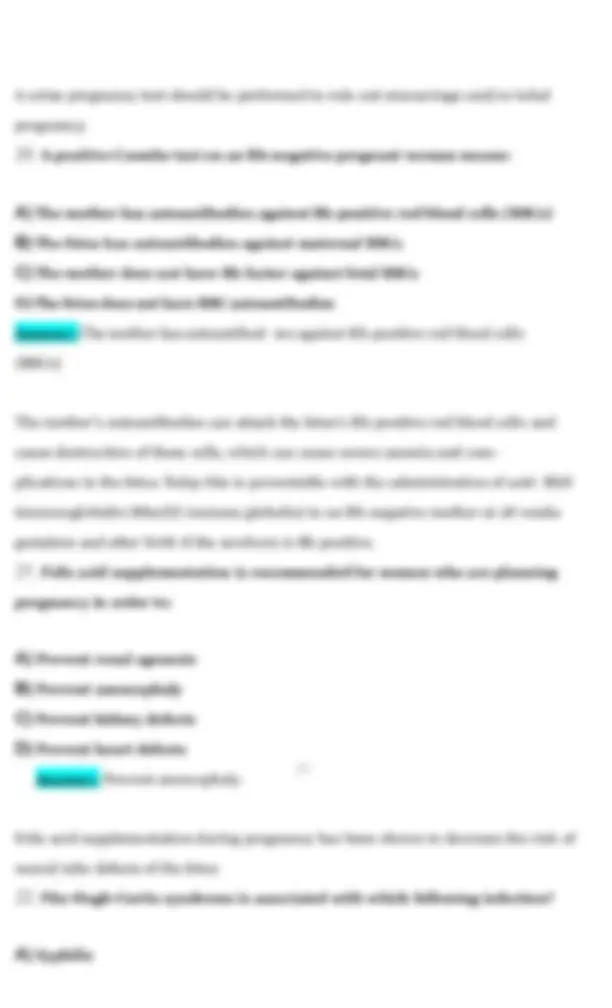

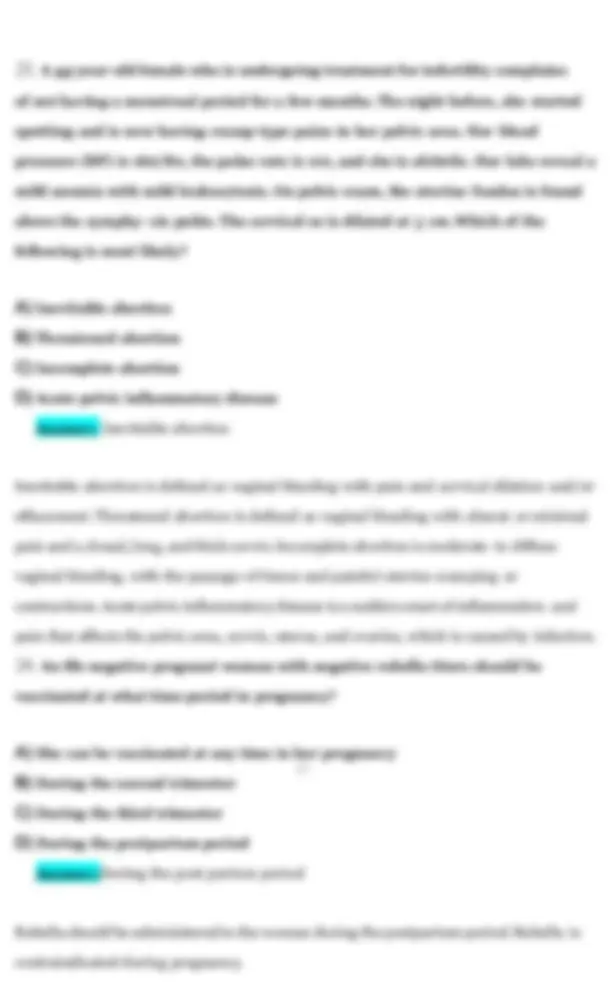

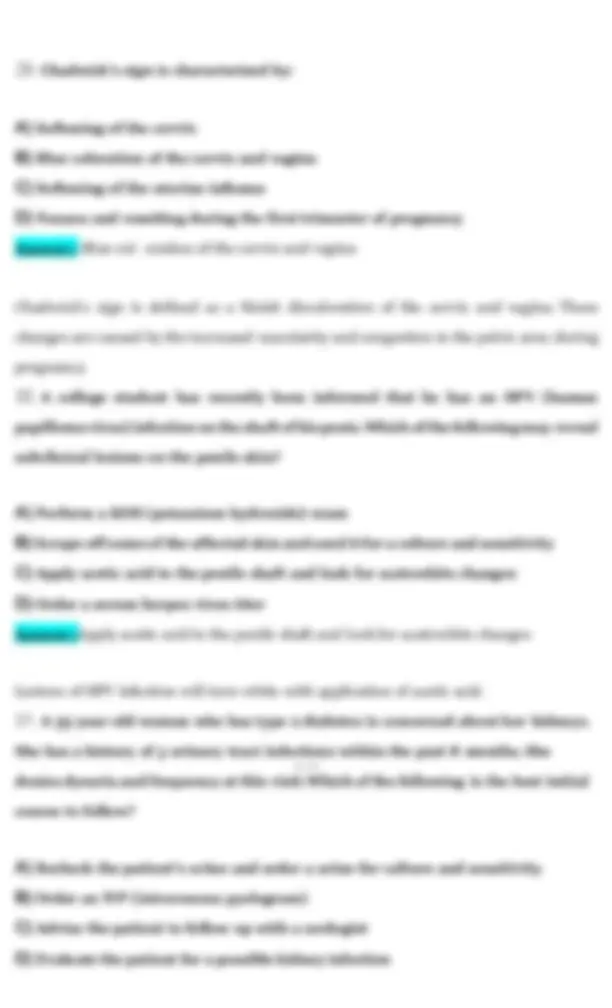

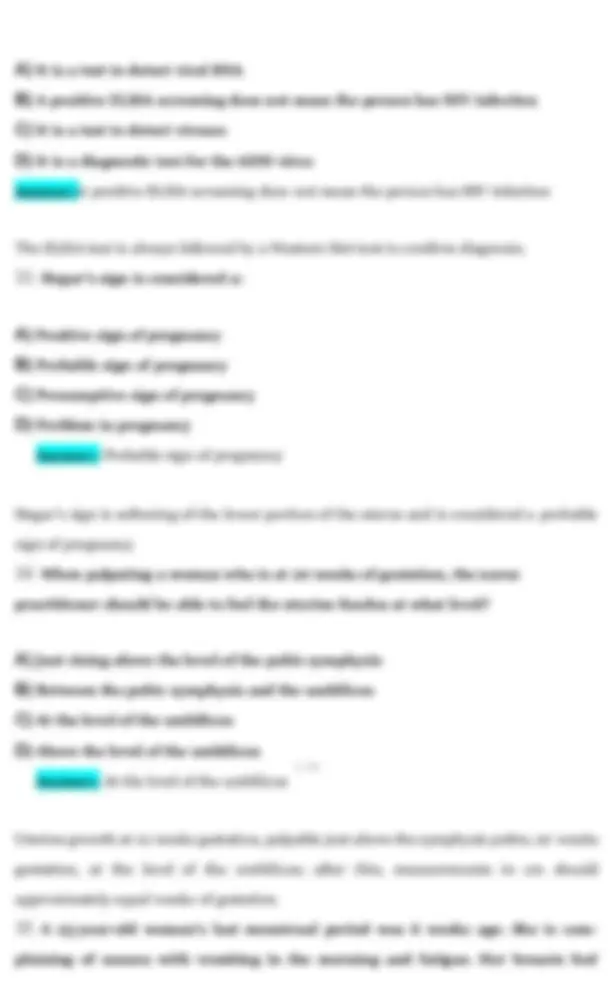

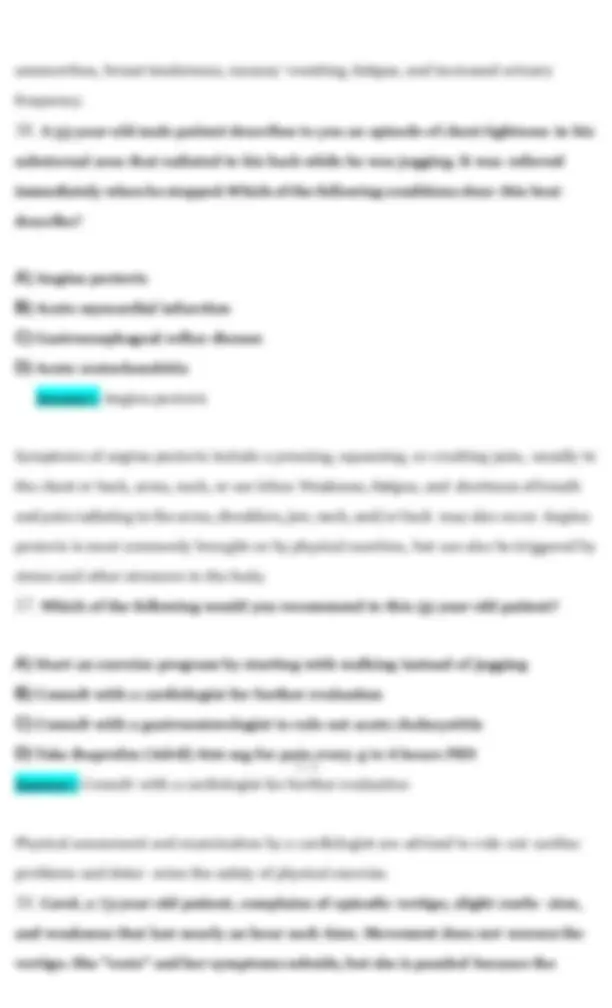

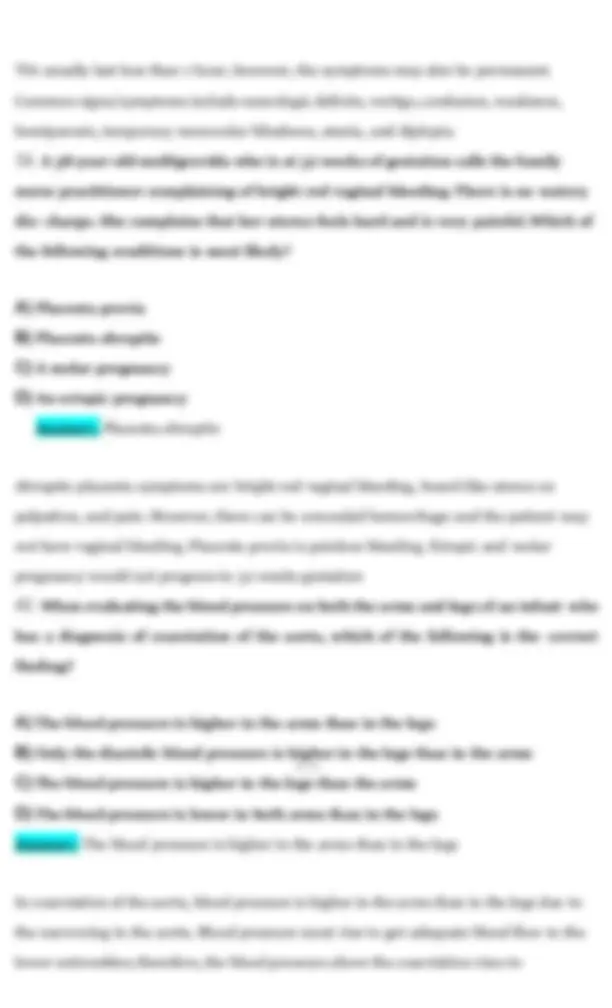

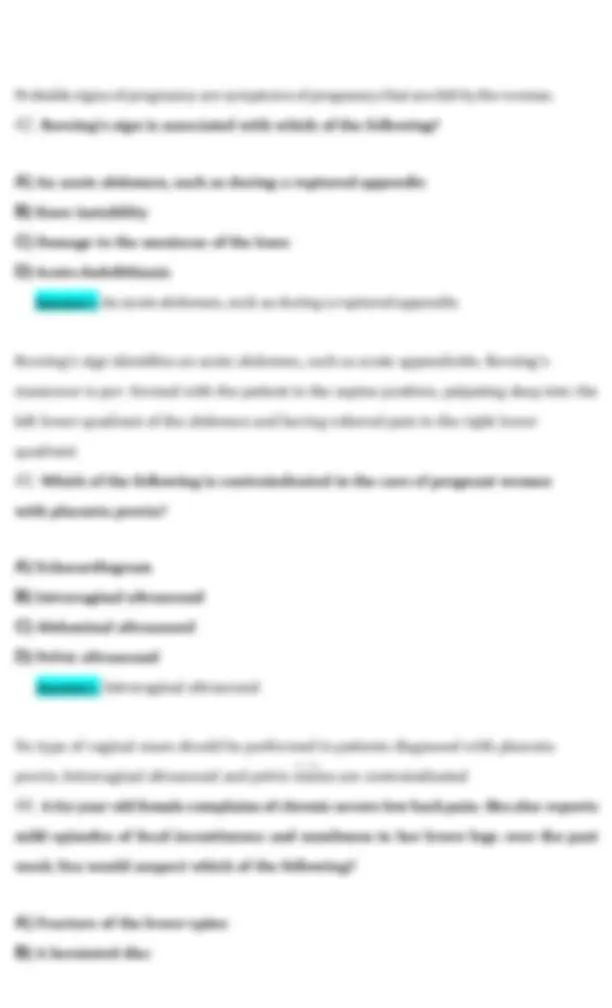

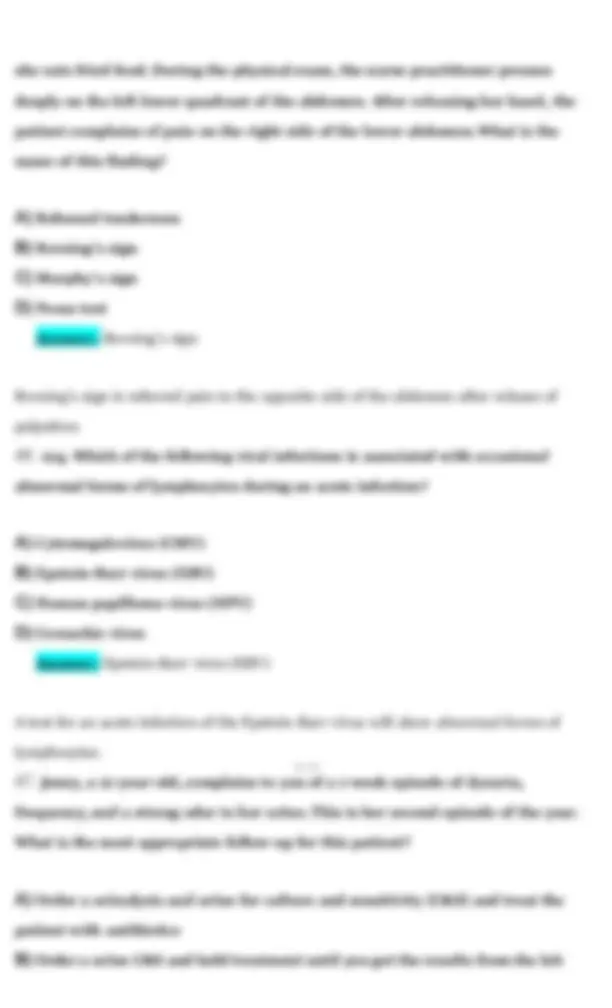

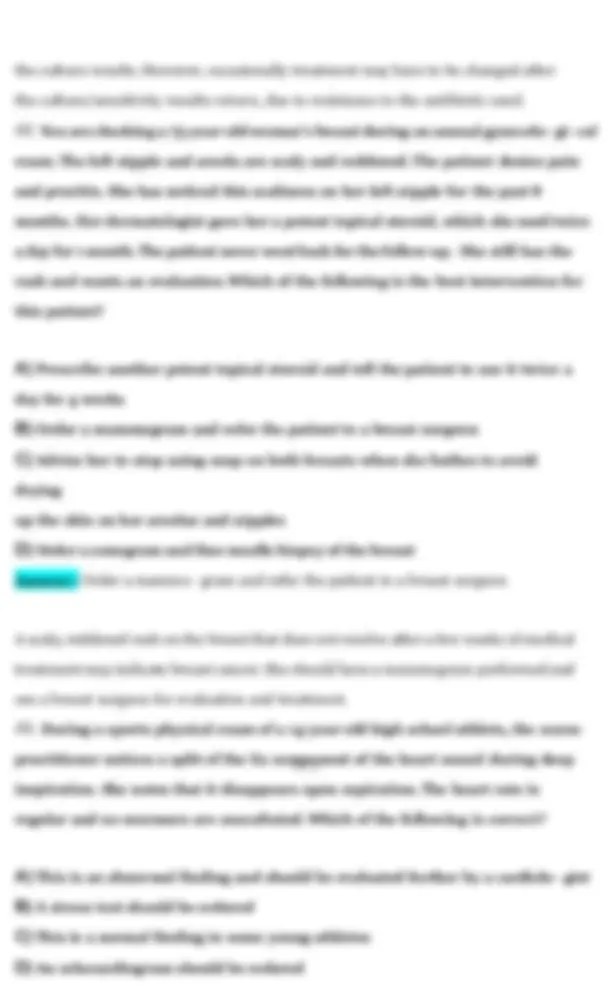

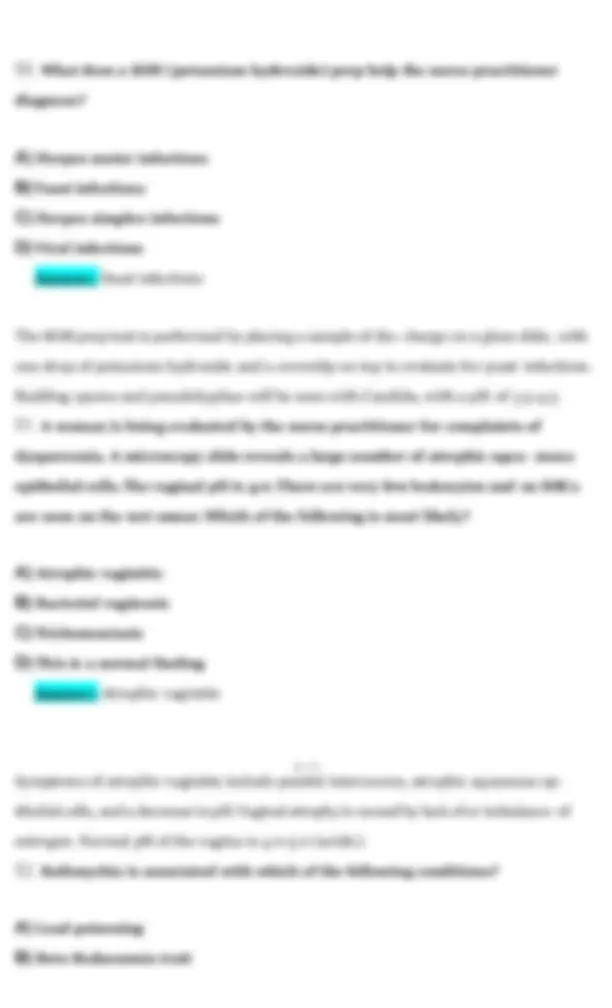

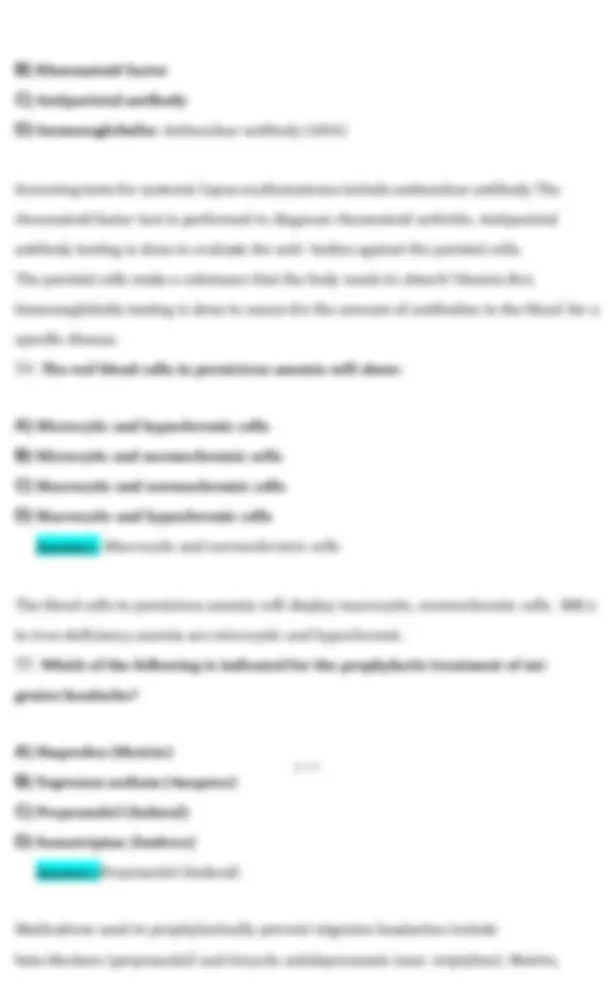

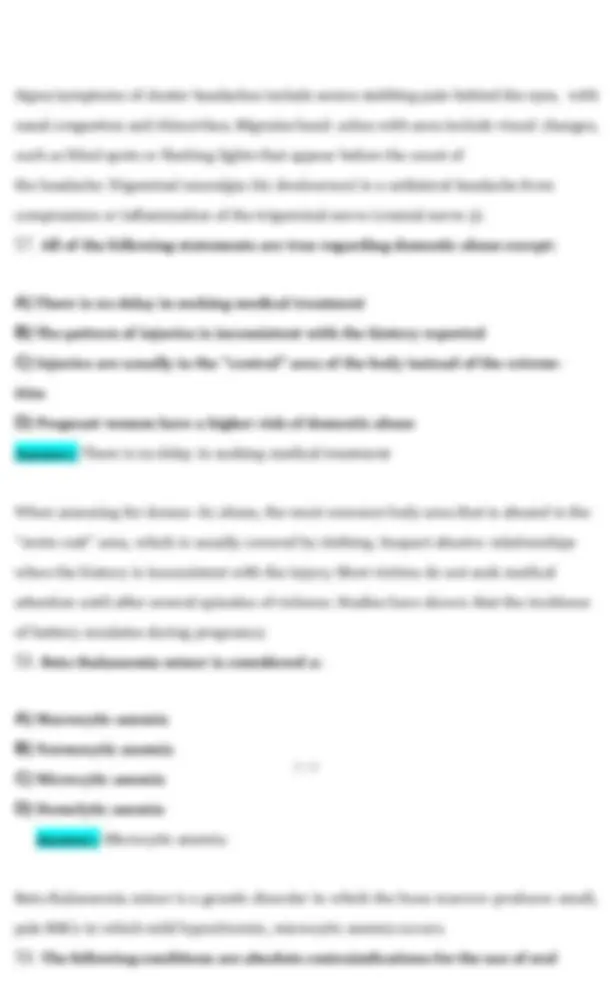

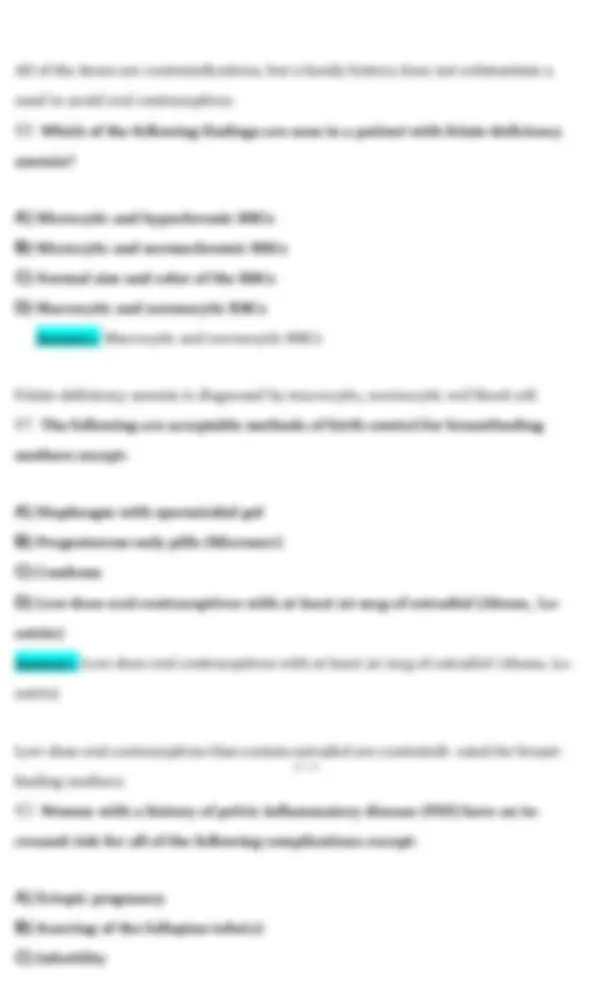

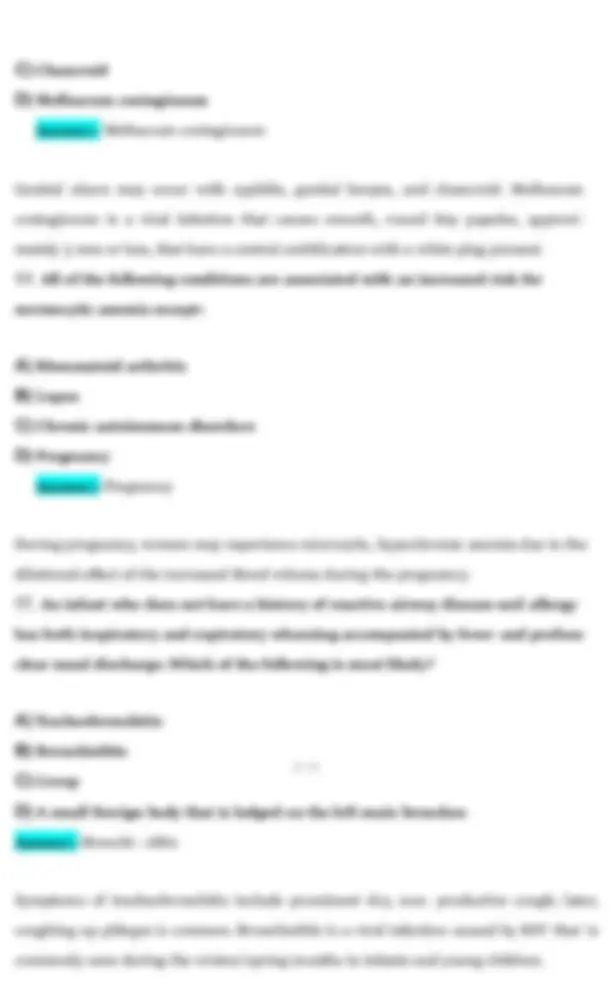

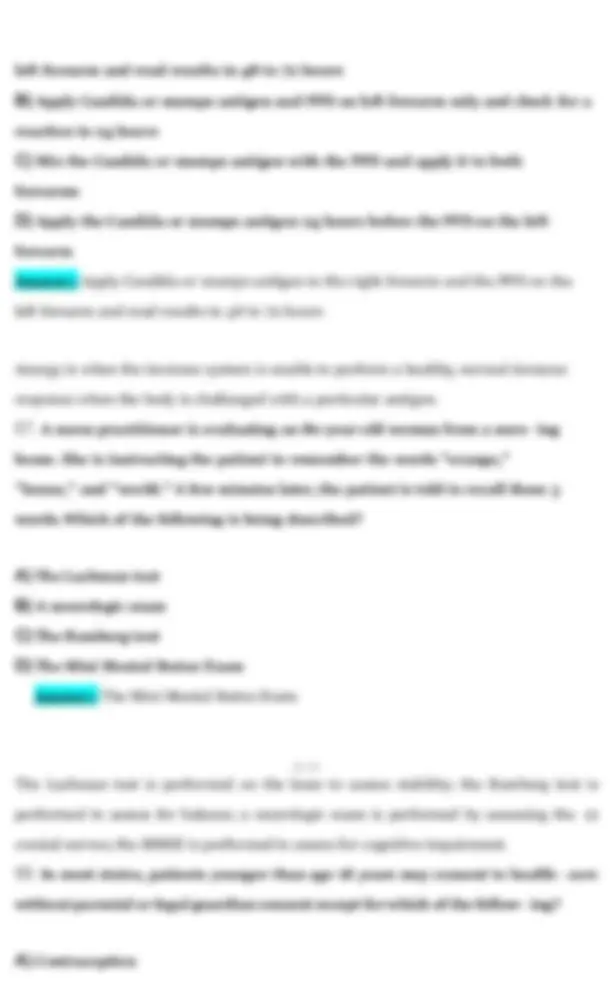

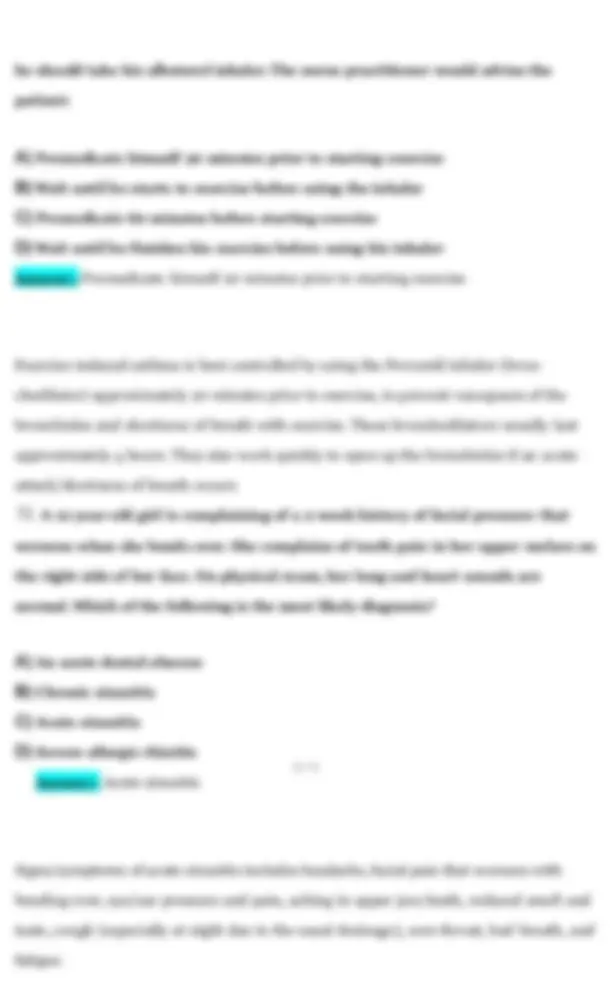

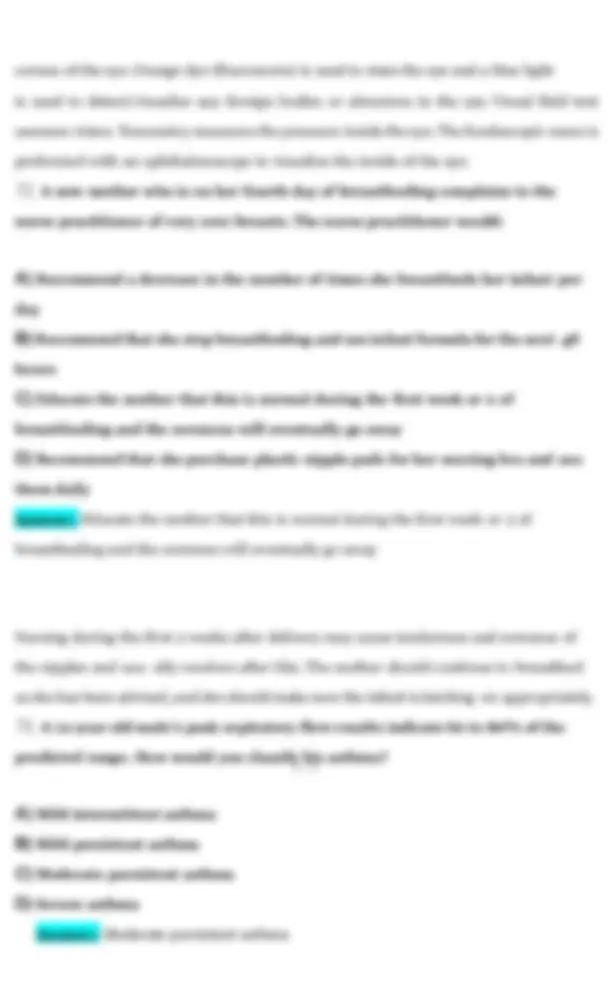

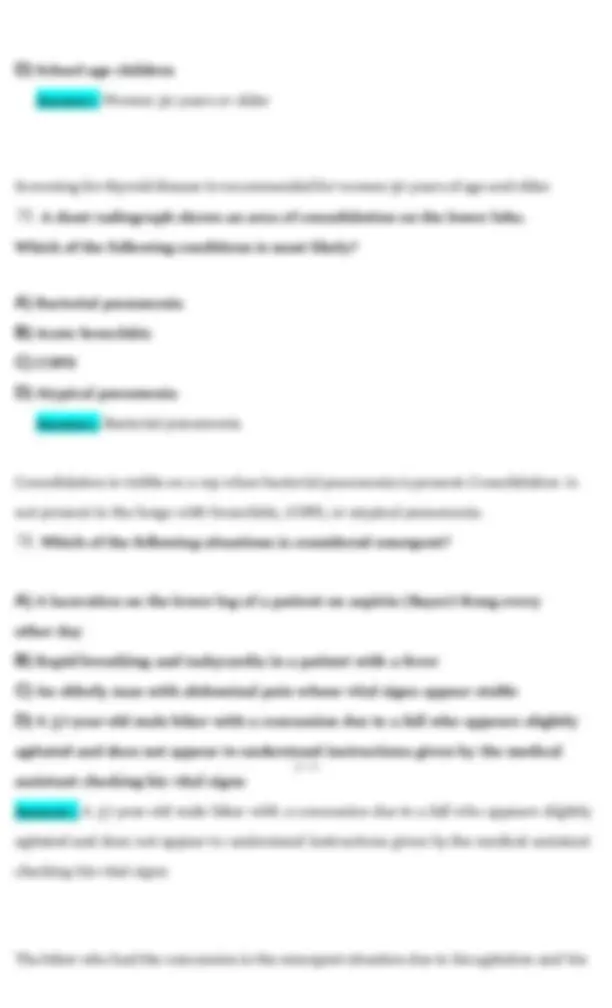

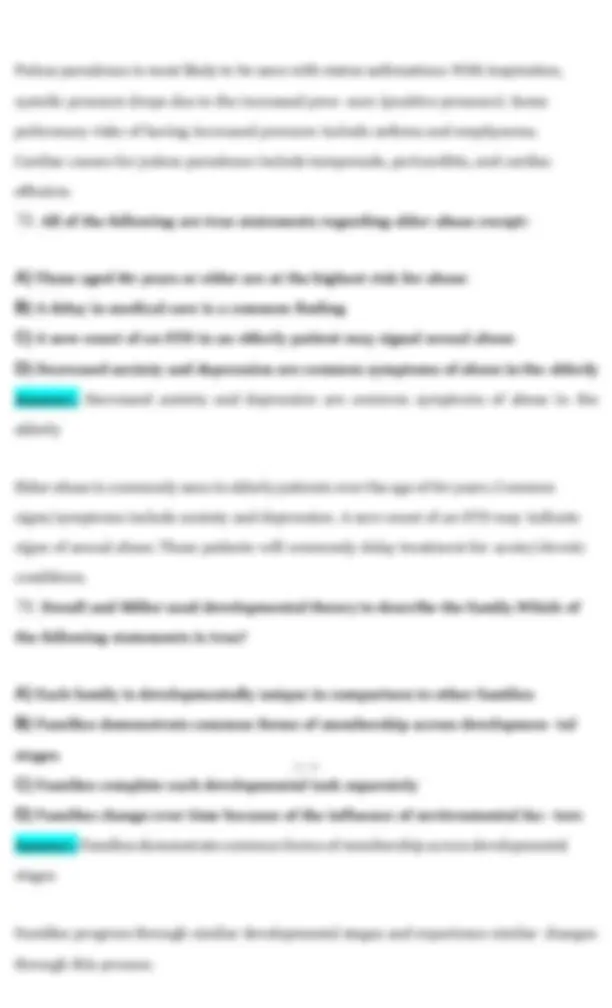

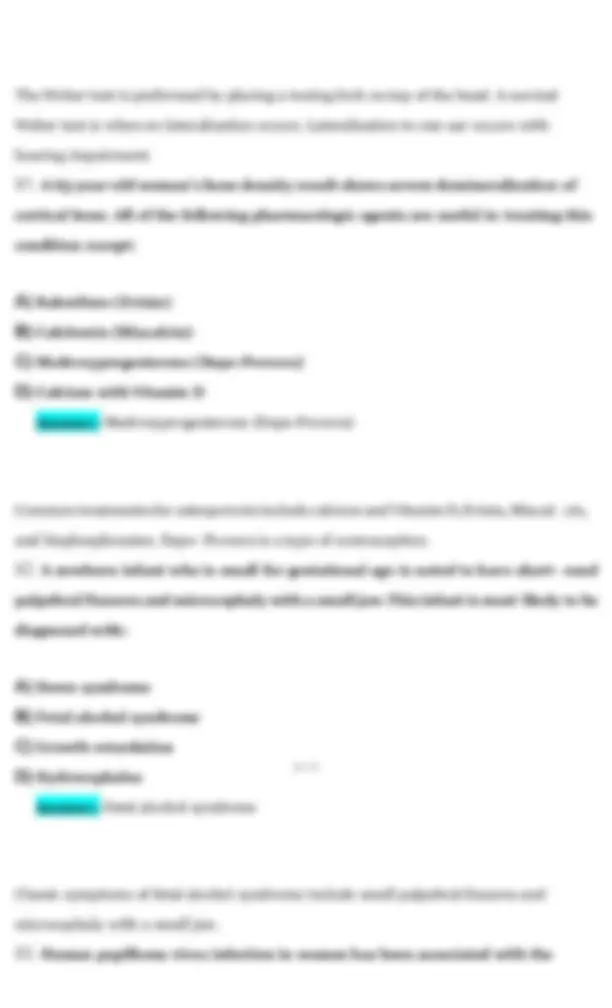

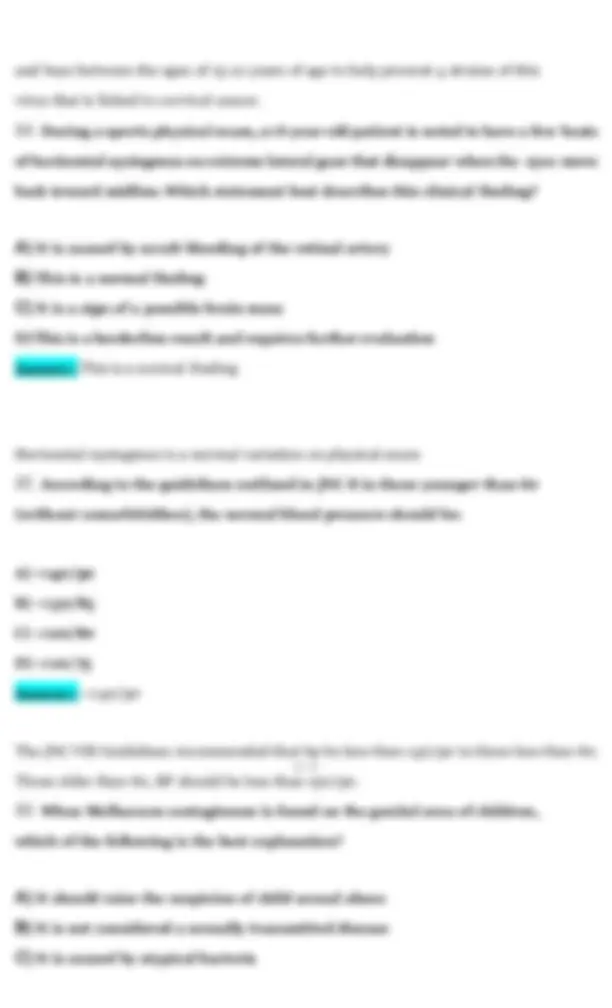

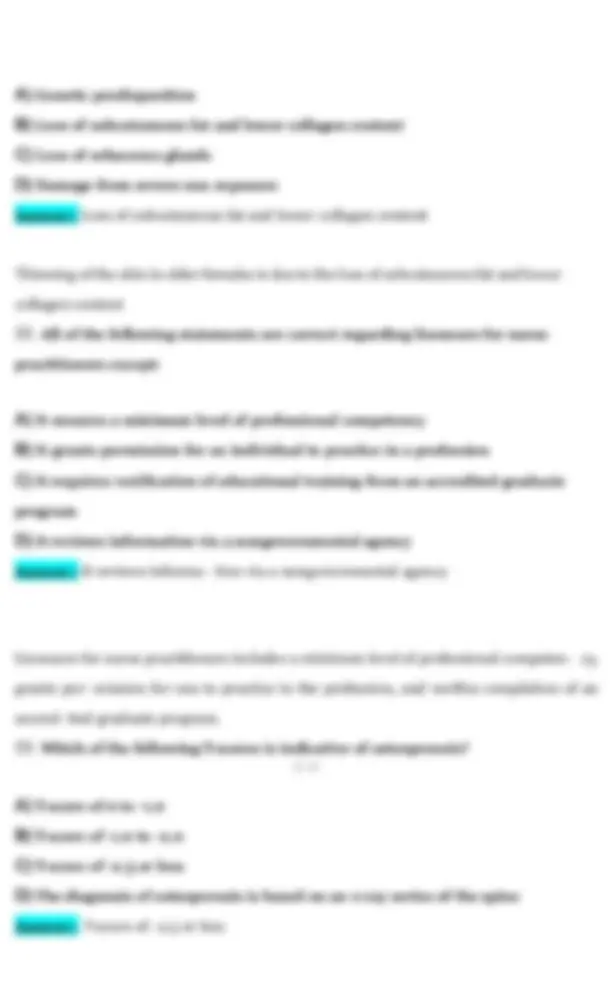

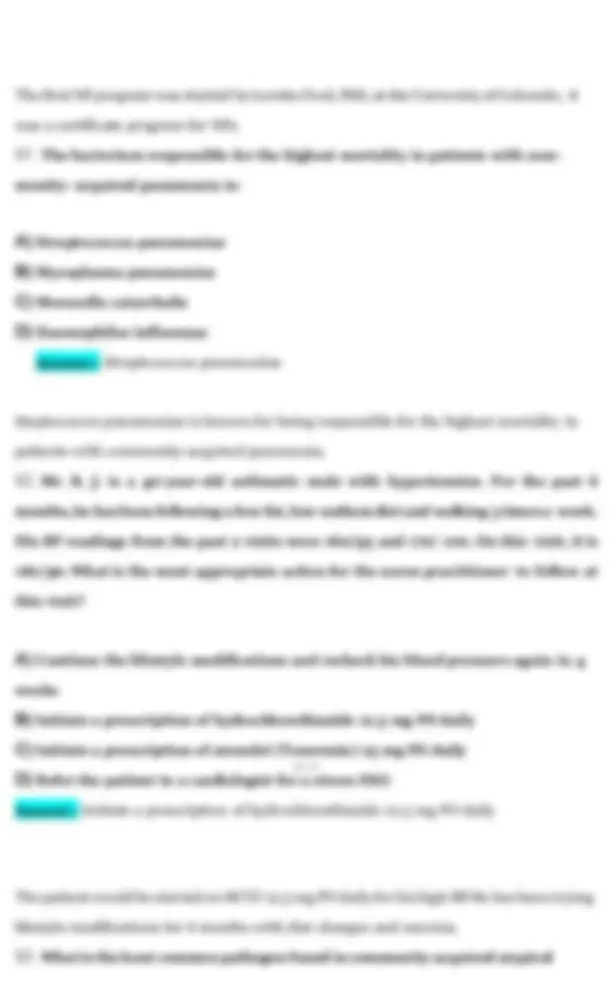

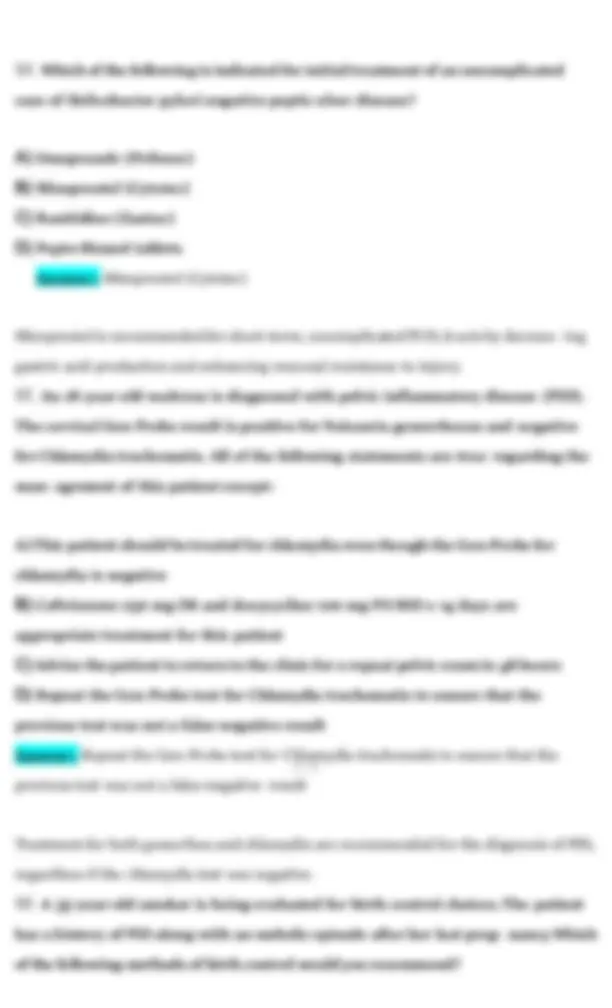

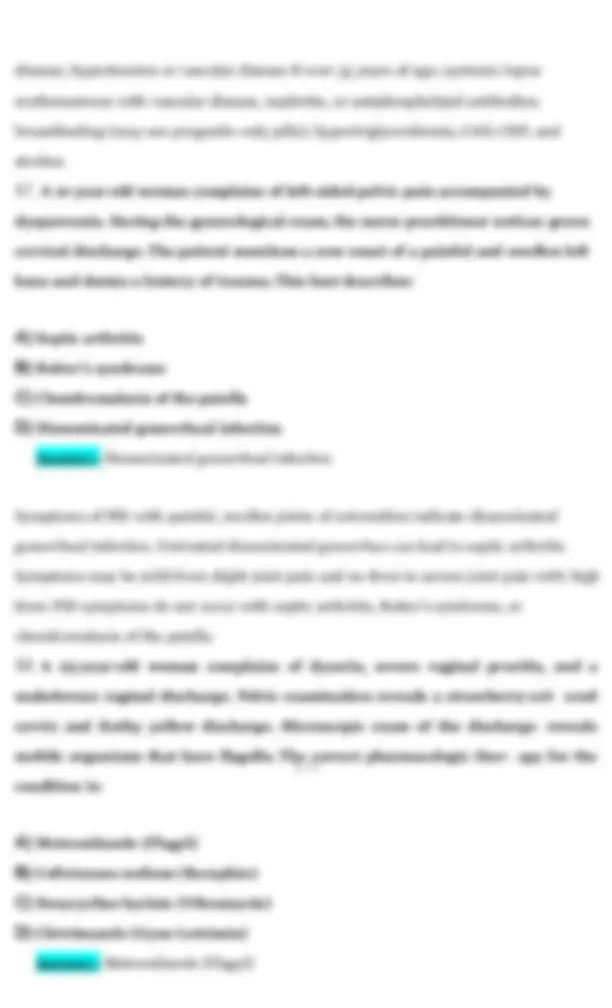

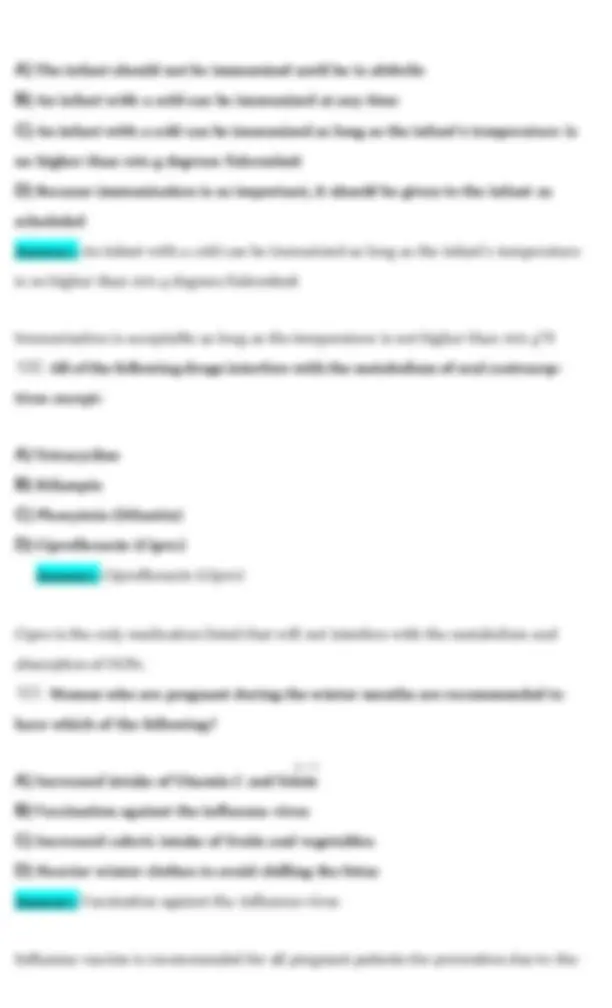

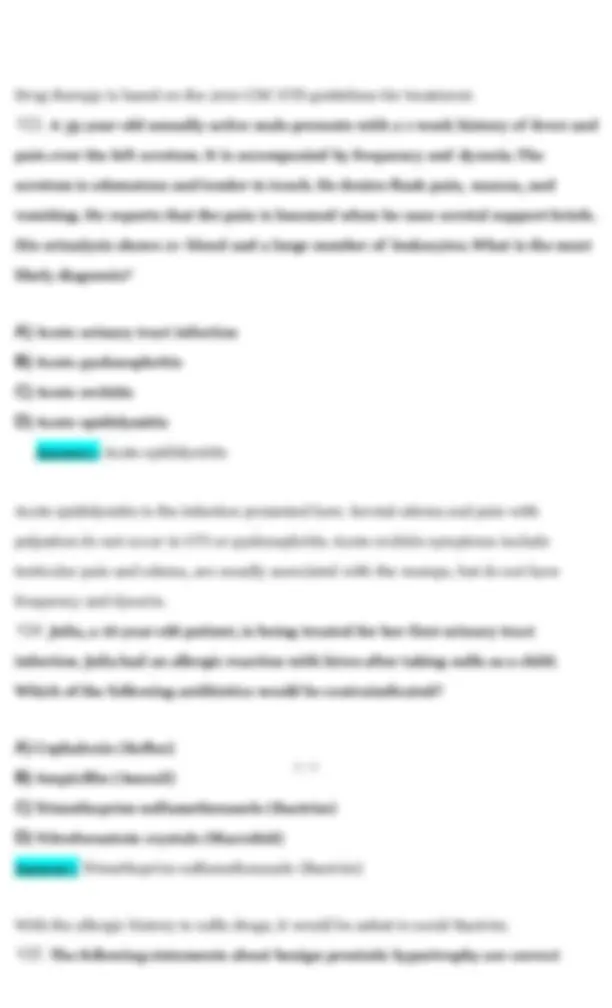

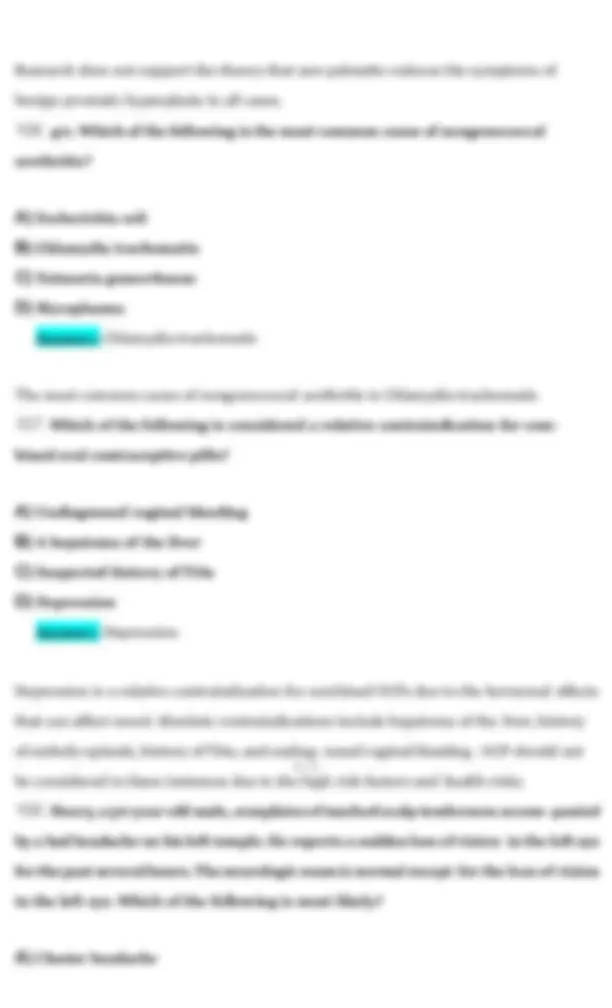

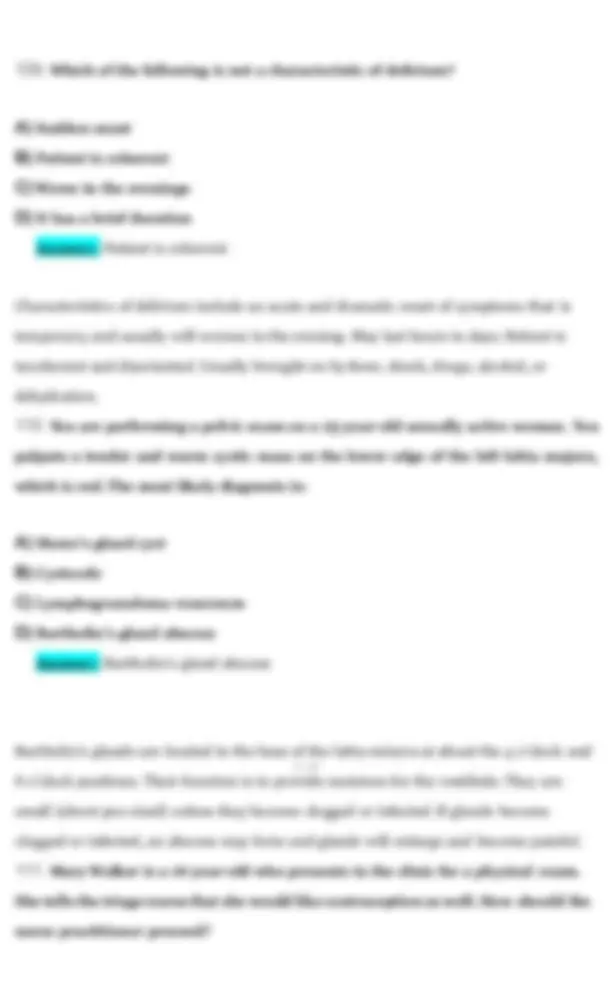

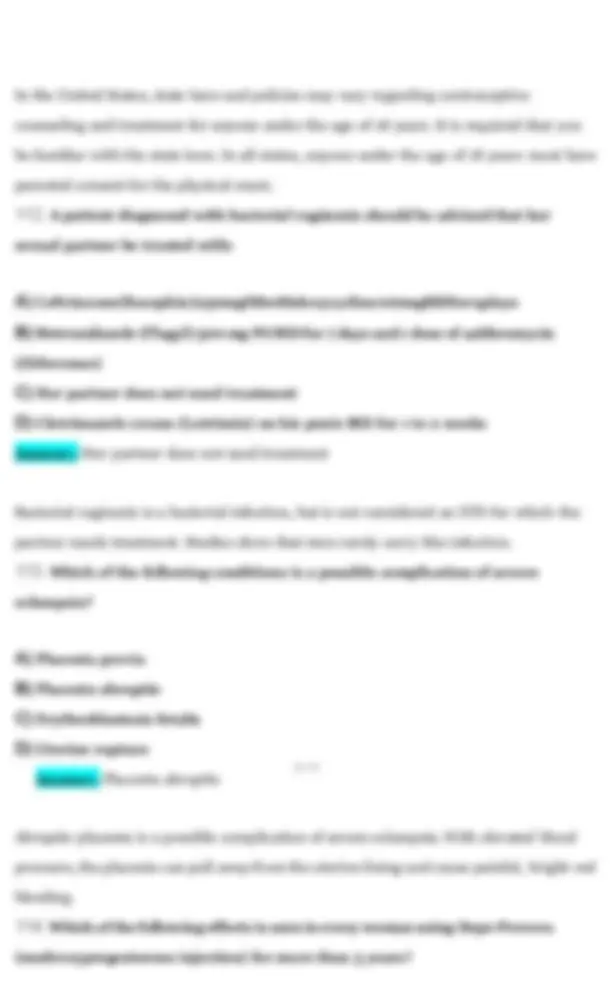

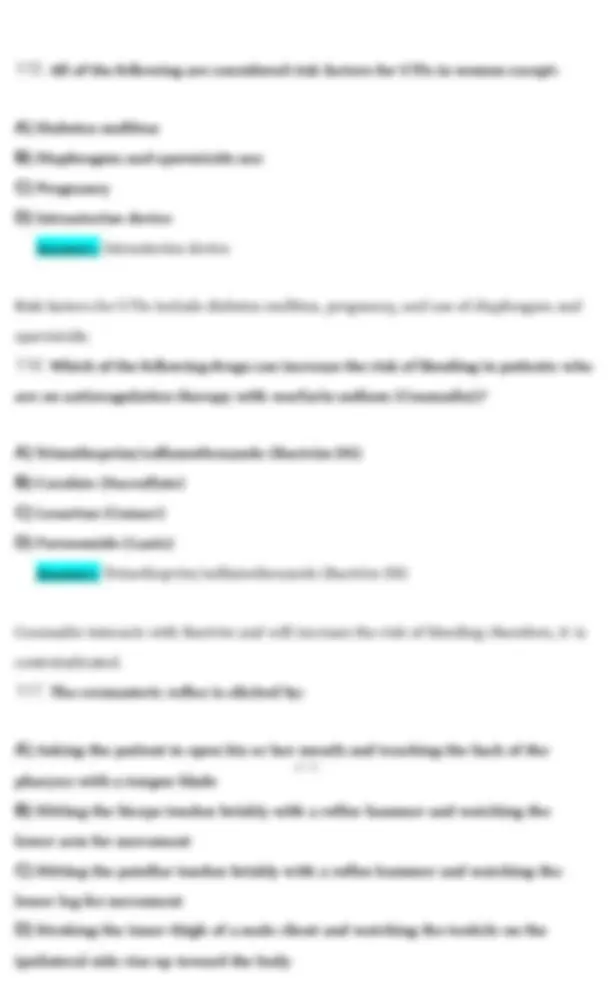

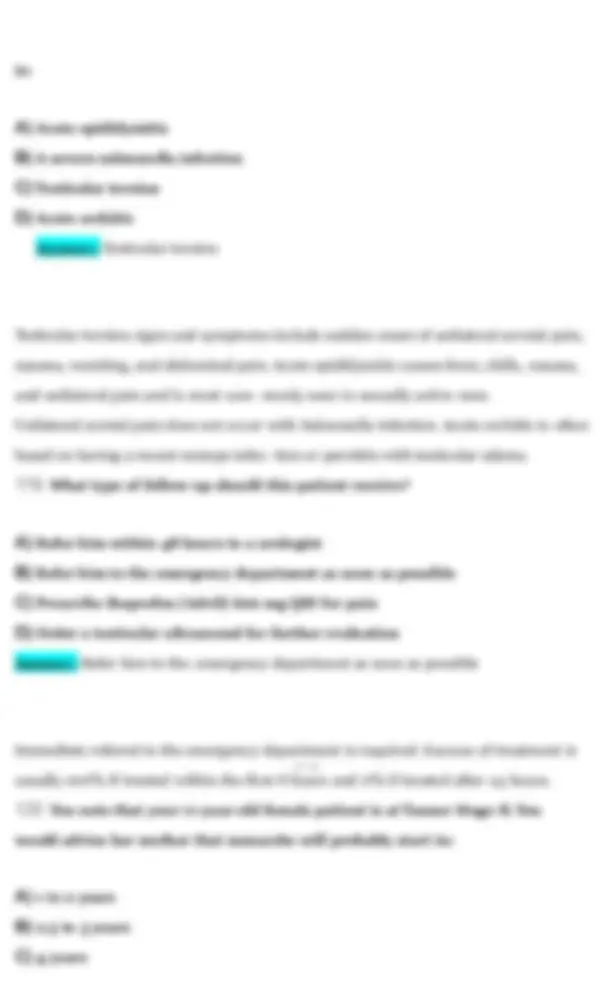

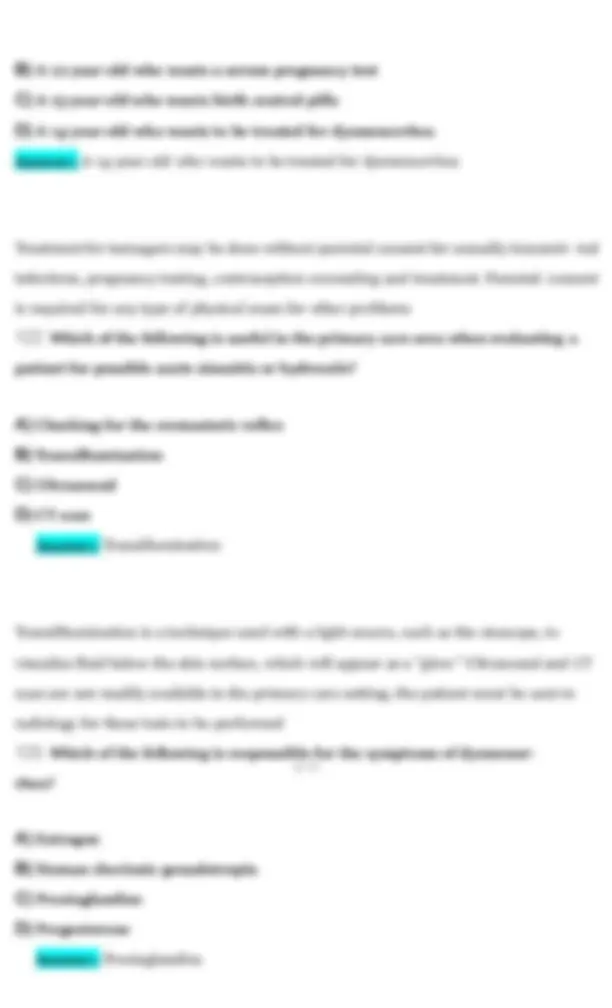

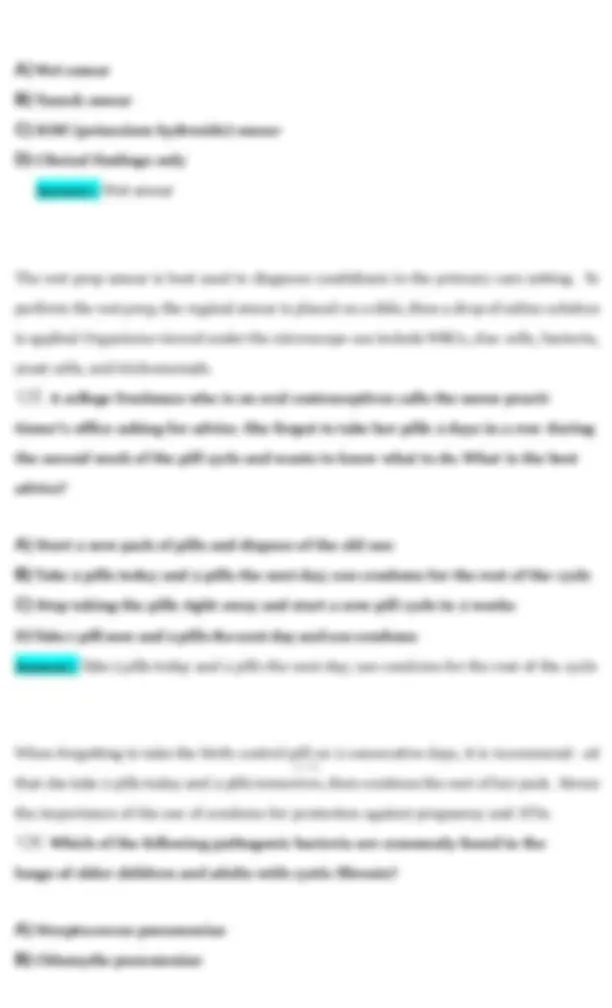

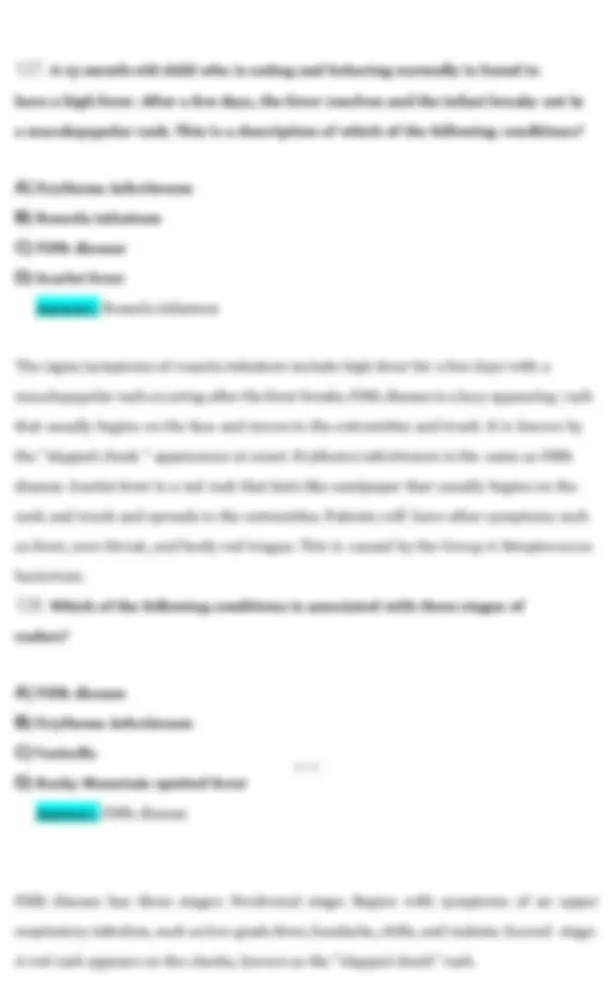

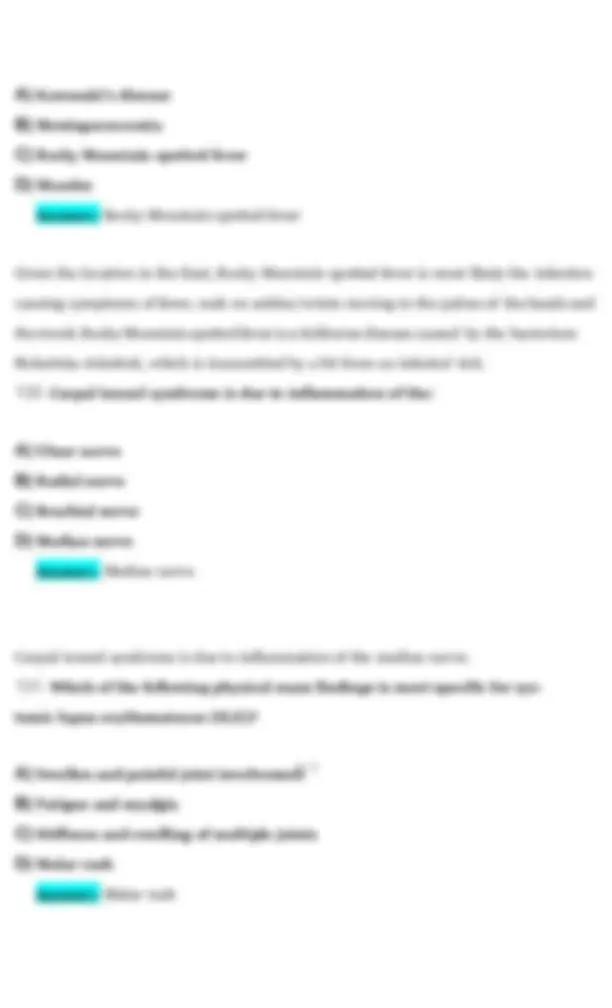

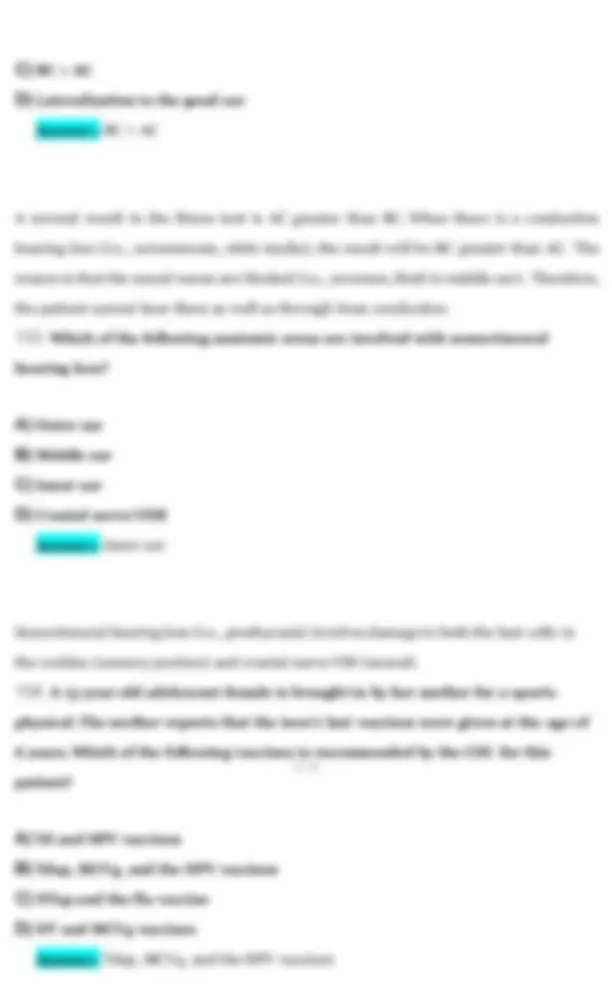

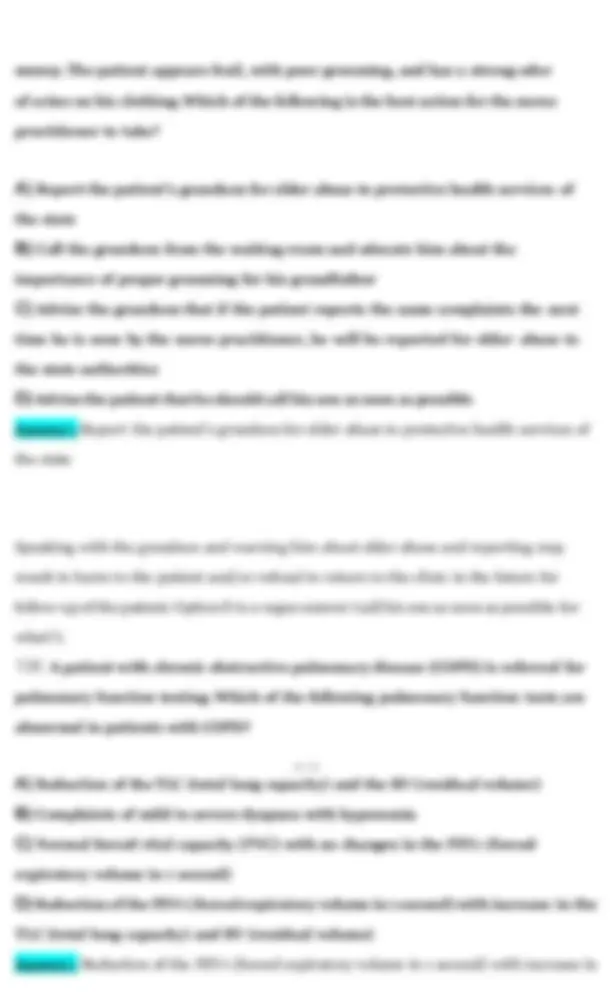

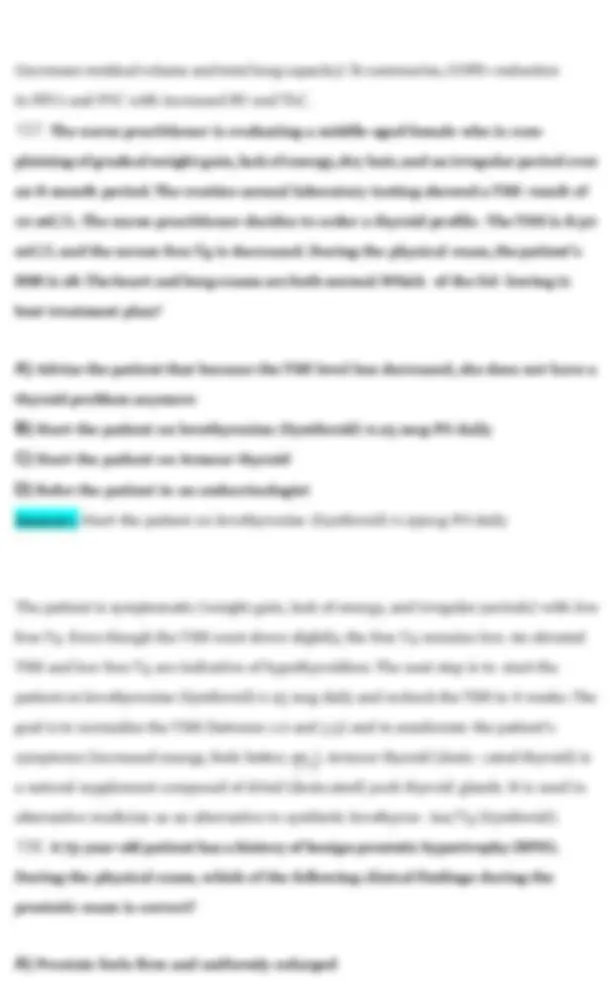

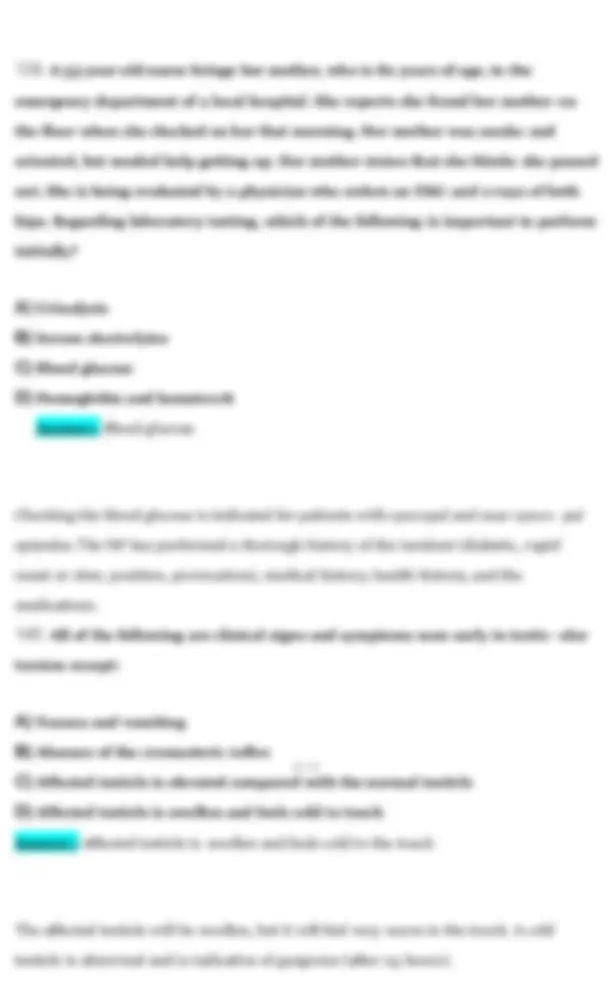

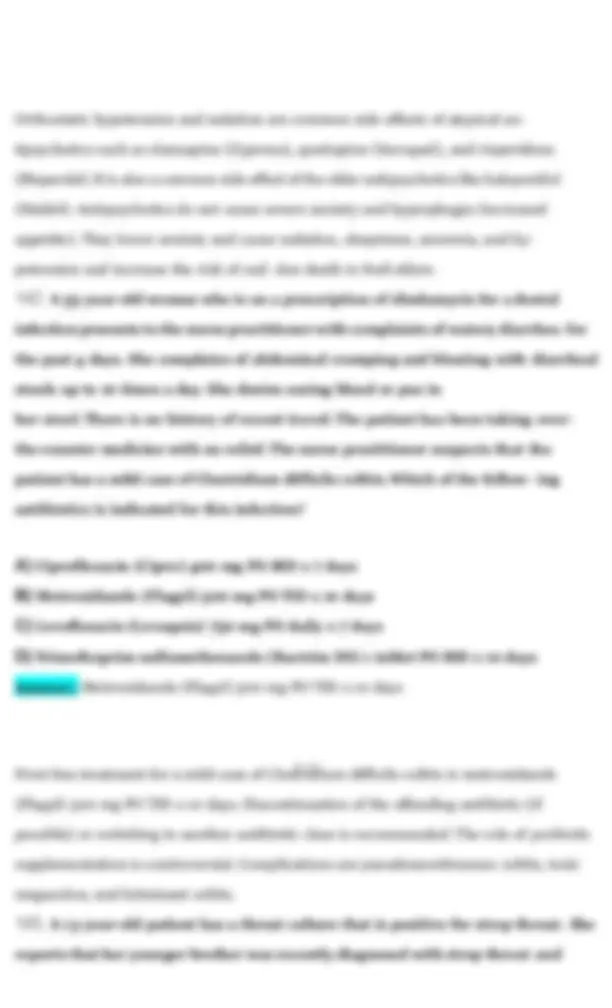

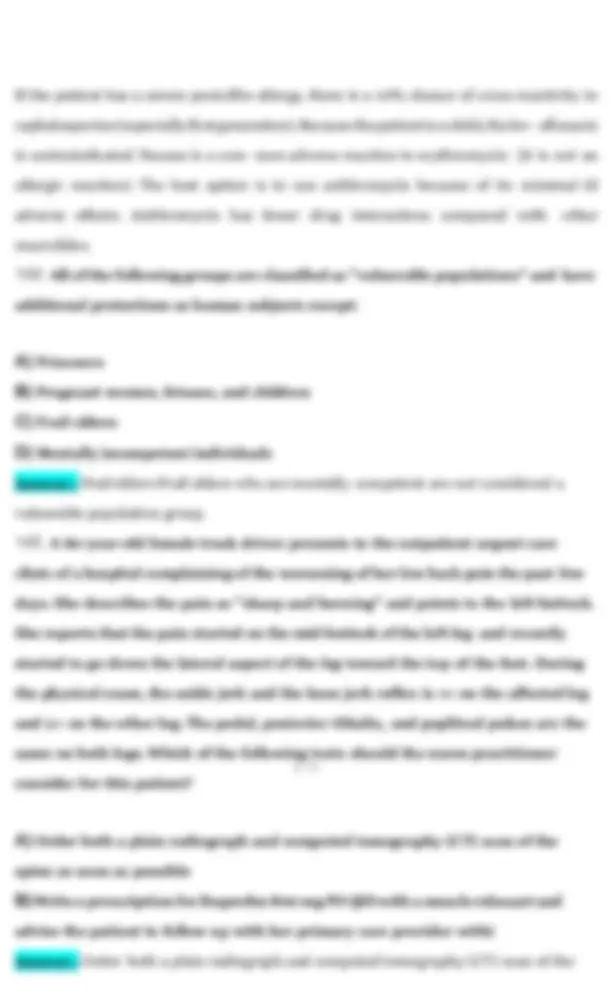

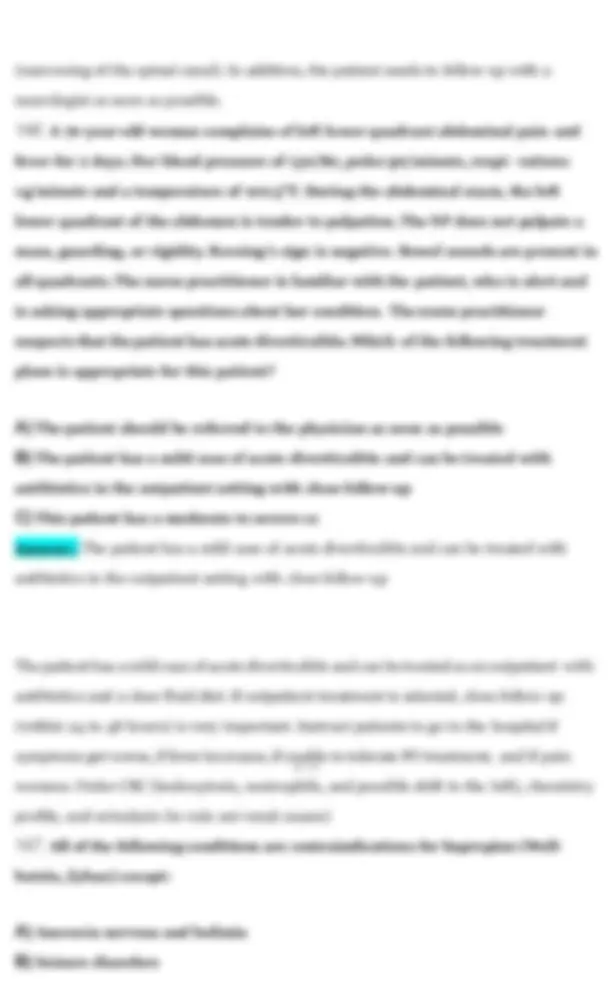



Study with the several resources on Docsity

Earn points by helping other students or get them with a premium plan


Prepare for your exams
Study with the several resources on Docsity

Earn points to download
Earn points by helping other students or get them with a premium plan
Community
Ask the community for help and clear up your study doubts
Discover the best universities in your country according to Docsity users
Free resources
Download our free guides on studying techniques, anxiety management strategies, and thesis advice from Docsity tutors
Comprehensive Family Nurse Practitioner (FNP) exam review based on the Leik study guide. Includes over 100 clinically focused multiple-choice questions with answers and rationales, covering pharmacology, diagnosis, and primary care scenarios. Ideal for board certification prep (AANP/ANCC). fnp exam review, nurse practitioner questions, leik study guide, fnp practice test, nurse practitioner exam prep, fnp review book, fnp pharmacology quiz, fnp board review, aanp practice questions, fnp exam workbook
Typology: Exams
1 / 139

This page cannot be seen from the preview
Don't miss anything!





























































































1 / 70
A) Bacterialvaginosis B) Candidiasis C) Trichomoniasis D) Chlamydia trachomatis Answer> Chlamydia trachomatis
Infections that commonly affect the labia and vagina include bacterial vaginosis, can- didiasis, and trichomoniasis. Chlamydia trachomatis commonly affects the cervix, endometrial lining , fallopian tubes, and pelvic cavity.
A) Bed rest except for bathroom privileges B) Close monitoring of weight and blood pressure C) Close follow-up of urinary protein, serum creatinine, and platelet count D) A prescription of methyldopa (Aldomet) to control blood pressure Answer> A prescription of methyldopa (Aldomet) to control blood pressure
Recommended care for women diagnosed with preeclampsia includes bed rest with bath- room privileges, weight and BP monitoring, and closely following urine protein and serum protein, creatinine, and platelet counts. Oral medications are not used as first- line treatment.
A) Abdominal cramping and constipation B) Edema of the face and the upper extremities C) Shortness of breath D) Dysuria and frequency
2 / 70
Answer> Edema of the face and the upper extremities
Common signs and symptoms of pregnancy-induced hypertension include edema of the face and the upper extremities, weight gain, blurred vision, elevated BP, proteinuria, and headaches.
4 / 70
fetoprotein are commonly seen in multiple gestations due to the growing fetuses and enlargement of the livers.
A) Calcium channel blocker B) Angiotensin-converting enzyme (ACE) inhibitor C) Beta-blocker D) Diuretic Answer> Calcium channel blocker
5 / 70
Calcium channel blockers act by blocking the cal- cium channels in the heart muscle and the blood vessels, thereby keeping more calcium in the bones.
A) Tanner Stage II B) Tanner Stage III C) Tanner Stage IV D) Tanner Stage V Answer> Tanner Stage III
Tanner Stage III in males consists of penis lengthening and darker, coarse pubic hair, which begins to curl
A) Toxoplasma gondii, other infections, rubella, cytomegalovirus, and herpes B) Toxic shock syndrome, ocular infections, rubella, cytomegalovirus, and herpes zoster C) Tetanus, ophthalmic infections, roseola, cancer, and head abnormalities D) Toxins, other infections, roseola, candidiasis, and head abnormalities Answer> Toxoplasmagondii, other infections, rubella, cytomegalovirus, and herpes
The acronym TORCH stands for Toxoplasma gondii, other infections, rubella, cy- tomegalovirus, and herpes. Although several of the conditions listed in the other answer options can also cause fetal problems, they are not included in the TORCH acronym.
7 / 70
than 2 cm within the gestational week of pregnancy, further testing should be performed to evaluate fetal growth
A) Midway between the umbilicus and the lower ribs B) At the level of the umbilicus C) From 33 to 35 cm D) From 32 to 34 cm Answer> From 33 to 35 cm
After 20 weeks gestation, fundal height in centimeters should measure approximate- ly the same as the number of weeks of gestation
A) Anhedonia and changes in appetite B) Decreased energy and irritability C) Apathy and low self-esteem D) Apraxia and fatigue Answer> Apraxia and fatigue
Apraxia is a disorder of the nervous system in which the brain is affected and the patient is unable to move the arms/legs when asked to do so. Common signs of depression include anhedonia (loss of interest in activities that the patient finds pleasurable), unintentional weight loss or gain, fatigue, change in appetite, insomnia or hypersomnia, feelings of guilt and worthlessness, and recurrent thoughts of suicide.
8 / 70
A) Placenta abruptio B) Placenta previa C) Acute cervicitis D) Molar pregnancy (hydatidiform mole) Answer> Placenta previa
Placenta previa occurs when abnormal implantation of the placenta occurs. A common symptom of placenta previa is painless, bright red bleeding.
10 / 70
A) Trichomonas infection B) Bacterial vaginosis C) Candidal infection D) A normal finding Answer> Bacterial vaginosis
Bacterial vaginosis is a bacterial infection of the vagina. Signs and symptoms include copious off-white to gray discharge with foul odor without vaginal erythema or irritation. Wet prep will show positive for clue cells. When performing a wet prep, the
11 / 70
"whiff test" will be positive for a strong "fishy" odor when vaginal discharge is mixed with one drop of KOH.
A) The NP needs to do cervical cultures to verify the presence of gonorrhea B) Prescribe metronidazole vaginal cream for the patient over the phone C) Call the patient and tell her she needs a repeat Pap smear in 6 months D) Advise the patient to use a Betadine douche at bedtime x 3 days Answer> The NP needs to do cervical cultures to verify the presence of gonor- rhea
Cultures should be taken at the time of the Pap smear, as the patient may not return for later diagnostic testing.
A) Urine for culture and sensitivity B) 24-hour urine for protein and creatinine clearance C) 24-hour urine for microalbumin D) An intravenous pyelogram Answer> Urine for culture and sensitivity
An 8-year-old male patient with the diagnosis of diabetes has a high risk of urinary tract infections. A large amount of leukocytes in the urinalysis is abnormal and he has been having symptoms of frequency and nocturia for the past 3 days. The urine culture would be ordered because he has a high risk of infection. The urine culture and
13 / 70
A urine pregnancy test should be performed to rule out miscarriage and/or tubal pregnancy.
A) The mother has autoantibodies against Rh-positive red blood cells (RBCs) B) The fetus has autoantibodies against maternal RBCs C) The mother does not have Rh factor against fetal RBCs D) The fetus does not have RBC autoantibodies Answer> The mother has autoantibod- ies against Rh-positive red blood cells (RBCs)
The mother's autoantibodies can attack the fetus's Rh-positive red blood cells and cause destruction of these cells, which can cause severe anemia and com- plications in the fetus. Today this is preventable with the administration of anti- RhD immunoglobulin (Rho(D) immune globulin) to an Rh-negative mother at 28 weeks gestation and after birth if the newborn is Rh positive.
A) Prevent renal agenesis B) Prevent anencephaly C) Prevent kidney defects D) Prevent heart defects Answer> Prevent anencephaly
Folic acid supplementation during pregnancy has been shown to decrease the risk of neural tube defects of the fetus
A) Syphilis
14 / 70
B) Chlamydia trachomatis C) Herpes genitalis D) Lymphogranuloma venereum Answer> Chlamydia trachomatis
Fitz-Hugh-Curtis is a complication of having pelvic inflammatory disease that was caused by a vaginal infection, such as gonorrhea or Chlamydia trachomatis. This causes inflammation and infection in the pelvic cavity. Left untreated, this infection can cause adhesions that stretch from the peritoneum to the liver.
16 / 70
A) Foods with aspartame (Equal) because they can trigger migraines B) Foods with monosodium glutamate because they promote diuresis C) Foods with garlic because they promote hypertension D) Foods with nitrates because they do not induce flushing Answer> Foods with aspartame (Equal) because they can trigger migraines
17 / 70
Dietary triggers for migraine headaches include foods that contain aspartame, tyramine, nitrites, MSG, and/or red wine. These foods are thought to cause a change in the blood vessels and increased blood flow to the brain.
A) Placenta B) Hypothalamus C) Anterior pituitary D) Ovaries Answer> Placenta
HCG is produced by the placenta.
A) HELLP syndrome B) Pregnancy-induced hypertension (preeclampsia) C) Eclampsia of pregnancy D) Primary hypertension Answer> Pregnancy-induced hypertension (preeclampsia)
The classic triad of symptoms of preeclampsia includes hypertension, edema (weight gain), and proteinuria.
A) Palpation of the fetus and auscultation of the fetal heart tones by the nurse practitioner
10 / 70
A) Softening of the cervix B) Blue coloration of the cervix and vagina C) Softening of the uterine isthmus D) Nausea and vomiting during the first trimester of pregnancy Answer> Blue col- oration of the cervix and vagina
Chadwick's sign is defined as a bluish discoloration of the cervix and vagina. These changes are caused by the increased vascularity and congestion in the pelvic area during pregnancy.
A) Perform a KOH (potassium hydroxide) exam B) Scrape off some of the affected skin and send it for a culture and sensitivity C) Apply acetic acid to the penile shaft and look for acetowhite changes D) Order a serum herpes virus titer Answer> Apply acetic acid to the penile shaft and look for acetowhite changes
Lesions of HPV infection will turn white with application of acetic acid.
A) Recheck the patient's urine and order a urine for culture and sensitivity B) Order an IVP (intravenous pyelogram) C) Advise the patient to follow up with a urologist D) Evaluate the patient for a possible kidney infection
10 / 70
Answer> Recheck the patient's urine and order a urine for culture and sensitivity
A urinary tract infection is defined as the presence of 100,000 organisms per mL of urine in asymptomatic patients or greater than 100 organisms per mL or urine with pyuria (more than 7 WBCs/mL) in a symptomatic patient